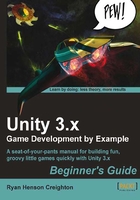
What this book covers
Chapter 1 That's One Fancy Hammer!, introduces you to Unity 3D—an amazing game engine that enables you to create games and deploy them to a number of different devices, including (at the time of writing) the Web, PCs, iOS platforms, Android devices, and marketplaces on all current generation consoles. You'll play a number of browser-based Unity 3D games to get a sense of what the engine can handle, from a massively-multiplayer online game all the way down to a simple kart racer. You'll download and install your own copy of Unity 3D, and atmospheric Angry Bots demo that ships with the product.
Chapter 2, Let's Start with the Sky, explores the difference between a game's skin and its mechanic. Using examples from video game history, including Worms, Mario Tennis, and Scorched Earth, we'll uncover the small, singular piece of joy upon which more complicated and impressive games are based. By concentrating on the building blocks of video games, we'll learn how to distil an unwieldy behemoth of a game concept down to a manageable starter project.
Chapter 3, Game #1: Ticker Taker, puts you in the pilot seat of your first Unity 3D game project. We'll explore the Unity environment and learn how to create and place primitives, add components like physic materials and rigidbodies, and make a ball bounce on a paddle using Unity's built-in physics engine without even breaking a sweat.
Chapter 4, Code Comfort, continues the keep-up game project by gently introducing scripting. Just by writing a few simple, thoroughly-explained lines of code, you can make the paddle follow the mouse around the screen to add some interactivity to the game. This chapter includes a crash course in game scripting that will renew your excitement for programming where high school computer classes may have failed you.
Chapter 5, Game#2: Robot Repair, introduces an often-overlooked aspect of game development: "front-of-house" user interface design—the buttons, logos, screens, dials, bars, and sliders that sit in front of your game—is a complete discipline unto itself. Unity 3D includes a very meaty Graphical User Interface system that allows you to create controls and fiddly bits to usher your players through your game. We'll explore this system, and start building a complete two-dimensional game with it! By the end of this chapter, you'll be halfway to completing Robot Repair, a colorful matching game with a twist.
Chapter 6, Game#2: Robot Repair Part 2, picks up where the last chapter left off. We'll add interactivity to our GUI-based game, and add important tools to our game development tool belt, including drawing random numbers and limiting player control. When you're finished with this chapter, you'll have a completely playable game using only the Unity GUI system, and you'll have enough initial knowledge to explore the system yourself to create new control schemes for your games.
Chapter 7, Don't be a Clock Blocker, is a standalone chapter that shows you how to build three different game clocks: a number-based clock, a depleting bar clock, and a cool pie wedge clock, all of which use the same underlying code. You can then add one of these clocks to any of the game projects in this book, or reuse the code in a game of your own.
Chapter 8, Ticker Taker, revisits the keep-up game from earlier chapters and replaces the simple primitives with 3D models. You'll learn how to create materials and apply them to models that you import from external art packages. You'll also learn how to detect collisions between Game Objects, and how to print score results to the screen. By the end of this chapter, you'll be well on your way to building Ticker Taker—a game where you bounce a still-beating human heart on a hospital dinner tray in a mad dash for the transplant ward!
Chapter 9, Game#3: The Break-Up is a wild ride through Unity's built-in particle system that enables you to create effects like smoke, fire, water, explosions, and magic. We'll learn how to add sparks and explosions to a 3D bomb model, and how to use scripting to play and stop animations on a 3D character. You'll need to know this stuff to complete The Break-Up—a catch game that has you grabbing falling beer steins and dodging explosives tossed out the window by your jilted girlfriend.
Chapter 10, Game#3: The Break-Up Part 2, completes The Break-Up game from the previous chapter. You'll learn how to reuse scripts on multiple Game Objects, and how to build prefabs, which enable you to modify a whole army of objects with a single click. You'll also learn to add sound effects to your games for a much more engaging experience.
Chapter 11, Game #4: Shoot the Moon, fulfills the promise of Chapter 2 by taking you through a re-skin exercise on The Break-Up. By swapping out a few models, changing the background, and adding a shooting mechanic, you'll turn a game about catching beer steins on terra firma into an action-packed space shooter! In this chapter, you'll learn how to set up a two-camera composite shot, how to use code to animate Game Objects, and how to re-jig your code to save time and effort.
Chapter 12, Action!, takes you triumphantly back to Ticker Taker for the coup de grace: a bouncing camera rig built with Unity's built-in animation system that flies through a model of a hospital interior. By using the two-camera composite from The Break-Up, you'll create the illusion that the player is actually running through the hospital bouncing a heart on a tin tray. The chapter ends with a refresher on bundling your project and deploying it to the Web so that your millions of adoring fans can finally experience your masterpiece.
Appendix, References, is packed with great Unity-related websites, resources, free game development tools and more. Don't miss it!